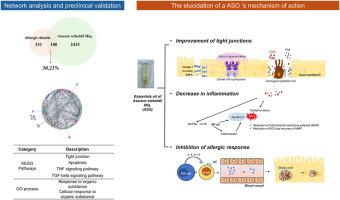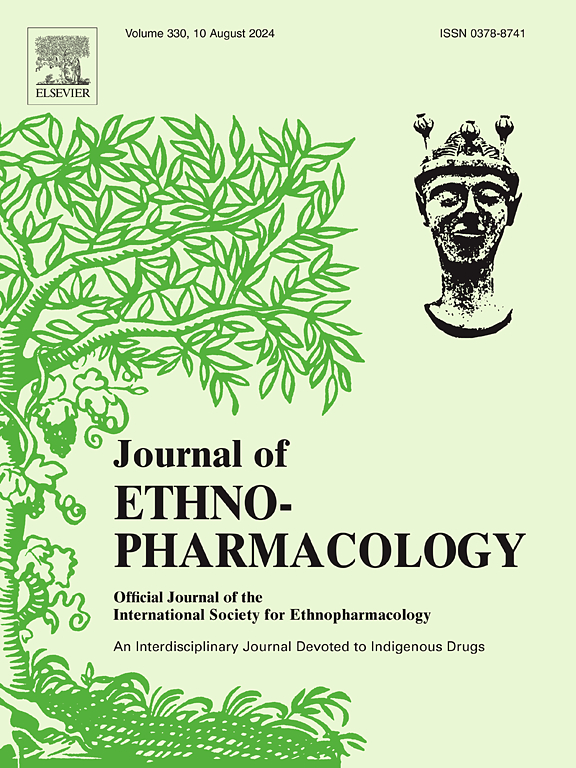The essential oils from Asarum sieboldii Miq. Alleviate allergic rhinitis by regulating tight junction and inflammation; Network analysis and preclinical validation
IF 4.8
2区 医学
Q1 CHEMISTRY, MEDICINAL
引用次数: 0
Abstract
Ethnopharmacological relevance
Essential oils from herbs, including those from Asarum sieboldii Miq., are readily absorbed through mucous membranes, explaining their widespread use in inhalation formulations. Asarum sieboldii Miq. has a long history of traditional use for various medicinal purposes, attributed to its anti-inflammatory, antiallergic, and antioxidant properties. Despite research on Asarum sieboldii Miq. for allergic inflammation in respiratory diseases, detailed mechanistic studies are still lacking.
Aim of the study
We utilized bioinformatics and network pharmacology to identify the effectiveness of Asarum sieboldii Miq. in treating allergic rhinitis (AR). Our aim is to elucidate the potential therapeutic effects of essential oil derived from Asarum sieboldii Miq. (ASO), which is recognized for its diverse pharmacological properties, on AR.
Materials and methods
Common genes associated with the active compounds of ASO and AR were utilized to construct a related network and predict their mode of action. AR was induced in BALB/c mice by exposing them to ovalbumin (OVA) and particulate matter 10 (PM10; airborne particles <10 μm). With induction, aerosolized ASO (0.0002% and 0.02%) were administered via nebulizer for 5 min per day, three times a week for 7 weeks. Mice were examined for histopathological changes in the nasal tissue, nasal epithelial inflammation, the production of allergen-specific cytokine response in vitro and in vivo.
Results
The common genes of ASO and AR were predicted to include 'Tight junction', 'Apoptosis', and 'TGF-beta signaling', which are the main pathways of pathogenesis in AR. Consistent with network prediction, nebulized ASO treatment effectively improved the expression of tight junction-related factors, zonula occludens-1, claudin-1, occludin and junction adhesion molecule A, in OVA + PM10 induced mice. Additionally, it reduced hyperplasia of nasal epithelial thickness, goblet cell counts, and inflammatory cell infiltration (eosinophils, neutrophils, macrophages, and lymphocytes) in nasal lavage fluid, while also alleviating allergic symptoms such as sneezing, rubbing, and serum IgE level when compared to the AR-induced group. The levels of mRNA and protein expression related to tight junctions were restored to normal levels by ASO, as confirmed in immunofluorescence analysis in nasal epithelial cells RPMI2650. Furthermore, treatment of ASO on PM10-treated nasal epithelial cells significantly reduced ROS production, recovered mitochondria membrane potential, and inhibition of the production of proinflammatory cytokines (TNF-α, IL-4, and IL-13) and inflammatory mediators linked to the MAPK/NF-κB signaling pathways.
Conclusion
Intranasal nebulization of ASO improves TJs and alleviates allergic nasal inflammation in AR. It supports the potential pharmaceutical application of ASO treatment for AR.

Asarum sieboldii Miq.通过调节紧密连接和炎症缓解过敏性鼻炎;网络分析和临床前验证。
民族药理学意义:草药精油(包括 Asarum sieboldii Miq.的精油)很容易被粘膜吸收,这也是它们被广泛用于吸入配方的原因。Asarum sieboldii Miq.具有抗炎、抗过敏和抗氧化等多种药用功效,其传统用途由来已久。尽管对 Asarum sieboldii Miq.治疗呼吸道疾病中的过敏性炎症进行了研究,但仍缺乏详细的机理研究:我们利用生物信息学和网络药理学来确定 Asarum sieboldii Miq.治疗过敏性鼻炎(AR)的有效性。我们的目的是阐明从Asarum sieboldii Miq.(材料与方法:利用与 ASO 和 AR 活性化合物相关的共同基因构建相关网络,并预测其作用模式。通过让 BALB/c 小鼠接触卵清蛋白(OVA)和颗粒物 10(PM10;空气中的颗粒物),诱导小鼠产生 AR:预测ASO和AR的共同基因包括 "紧密连接"、"细胞凋亡 "和 "TGF-beta信号",它们是AR的主要发病途径。与网络预测结果一致的是,雾化 ASO 能有效改善 OVA + PM10 诱导的小鼠体内紧密连接相关因子 Zonula occludens-1、claudin-1、occludin 和连接粘附分子 A 的表达。此外,与 AR 诱导组相比,它还能减少鼻腔灌洗液中鼻腔上皮增生厚度、鹅口疮细胞数量和炎症细胞浸润(嗜酸性粒细胞、中性粒细胞、巨噬细胞和淋巴细胞),同时还能减轻过敏症状,如打喷嚏、摩擦和血清 IgE 水平。鼻上皮细胞 RPMI2650 的免疫荧光分析证实,ASO 可使紧密连接相关的 mRNA 和蛋白质表达水平恢复到正常水平。此外,用 ASO 处理 PM10 处理过的鼻上皮细胞可显著减少 ROS 的产生,恢复线粒体膜电位,抑制促炎细胞因子(TNF-α、IL-4 和 IL-13)和与 MAPK/NF-κB 信号通路相关的炎症介质的产生:结论:雾化吸入 ASO 可改善 AR 的 TJ,缓解过敏性鼻炎。结论:雾化吸入 ASO 可改善 TJs,缓解 AR 的过敏性鼻炎,支持 ASO 治疗 AR 的潜在药物应用。
本文章由计算机程序翻译,如有差异,请以英文原文为准。
求助全文
约1分钟内获得全文
求助全文
来源期刊

Journal of ethnopharmacology
医学-全科医学与补充医学
CiteScore
10.30
自引率
5.60%
发文量
967
审稿时长
77 days
期刊介绍:
The Journal of Ethnopharmacology is dedicated to the exchange of information and understandings about people''s use of plants, fungi, animals, microorganisms and minerals and their biological and pharmacological effects based on the principles established through international conventions. Early people confronted with illness and disease, discovered a wealth of useful therapeutic agents in the plant and animal kingdoms. The empirical knowledge of these medicinal substances and their toxic potential was passed on by oral tradition and sometimes recorded in herbals and other texts on materia medica. Many valuable drugs of today (e.g., atropine, ephedrine, tubocurarine, digoxin, reserpine) came into use through the study of indigenous remedies. Chemists continue to use plant-derived drugs (e.g., morphine, taxol, physostigmine, quinidine, emetine) as prototypes in their attempts to develop more effective and less toxic medicinals.
 求助内容:
求助内容: 应助结果提醒方式:
应助结果提醒方式:


